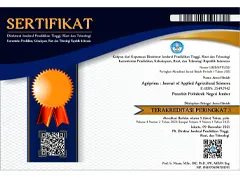Impact of Different Soil Management Practices and Fertilizer Combinations on Yield and Quality of Chicken Pea (Cicer arietinum L.)
DOI:
10.25047/agriprima.v7i2.541Downloads
Abstract
Soil cultivation practices and fertilizer managements significantly influence crop performance and yield. Our study aimed to evaluate the impact of different soil management techniques and the integration of organic and chemical fertilizers on the quantitative and qualitative performance of chicken peas (Cicer arietinum L.). Our results revealed that soil management and fertilizer sources had a significant impact on the number of pods per plant and seed yield. The highest number of pods per plant was observed in the conservation tillage treatment with 50% nitrogen fertilizer and mycorrhizal inoculation. The number of seeds per pod was influenced by fertilizer sources, with the highest number obtained in the treatment without soil amendment, 100% nitrogen fertilizer, and no mycorrhizal inoculation. Grain yield was highest in the conservation tillage treatment with 50% nitrogen fertilizer and mycorrhizal inoculation. The results highlighted that optimal nitrogen fertilizer integrated with mycorrhizal improves nutrient uptake and increases yield components. This study highlights the importance of fertilizer and soil management in optimizing chicken pea performance. The positive effects of balanced nitrogen fertilizer integrated with mycorrhizal inoculation were recorded on yield-related traits. These findings contribute to the development of sustainable agricultural practices that reduce reliance on chemical fertilizers and enhance crop productivity.
Keywords:
Mikoriza Nutrisi Potensi hasil Produktivitas tanaman Sistem pertanianReferences
Abete, I., Romaguera, D., Vieira, A. R., Lopez de Munain, A., & Norat, T. (2014). Association between total, processed, red and white meat consumption and all-cause, CVD and IHD mortality: a meta-analysis of cohort studies. British Journal of Nutrition, 112(5), 762–775. https://doi.org/10.1017/S000711451400124X
Alvarez, R., & Steinbach, H. S. (2009). A review of the effects of tillage systems on some soil physical properties, water content, nitrate availability and crops yield in the Argentine Pampas. Soil and Tillage Research, 104(1), 1–15. https://doi.org/10.1016/j.still.2009.02.005
Ardakani, M. R., Majd, F., & Noormohammadi, G. (2006). Evaluating the efficiency of mycorrhiza and esterpetomysis in phosphorous different levels and effect of their utilization on wheat yield. Iranian Journal of Agronomy Sciences, 2(2), 17-27. (In Persian).
Avian Petrody, M. A., Cherati, A. A., Safahani, A. R., & Alizadeh, G. R. (2011). The impact of crop residue management, tillage and nitrogen fertilizer on some qualitative and quantitative traits of soybean. 3rd International Conference Oilseeds and Edible Oils.
Cheragi, S., & Pezeshkpour, P. (2013). Investigation the different tillage methods and foliar application of nitrogen on yield and quantitative traits of mung bean. Crop Physiology Journal, 5(19), 85-97. (In Persian).
Chiremba, C., Vandenberg, A., Smits, J., Samaranayaka, A., Lam, R., & Hood-Niefer, S. (2018). New Opportunities for Faba Bean. Cereal Foods World, 63, 221–222. https://doi.org/10.1094/CFW-63-5-0221
Dawood, M. G., Abdel-Baky, Y. R., El-Awadi, M. E.-S., & Bakhoum, G. S. (2019). Enhancement quality and quantity of faba bean plants grown under sandy soil conditions by nicotinamide and/or humic acid application. Bulletin of the National Research Centre, 43(1), 28. https://doi.org/10.1186/s42269-019-0067-0
Herridge, D. F., Peoples, M. B., & Boddey, R. M. (2008). Global inputs of biological nitrogen fixation in agricultural systems. Plant and Soil, 311(1–2), 1–18. https://doi.org/10.1007/s11104-008-9668-3
Jackson, M. C. (1964). Soil chemical analysis. Constable and Co. Ltd.
Karami Chame, S., Khalil-Tahmasbi, B., ShahMahmoodi, P., Abdollahi, A., Fathi, A., Mousavi, S. J. S., & Bahamin, S. (2016). Effects of salinity stress, salicylic acid and pseudomonas on the physiological characteristics and yield of seed beans (Phaseolus vulgaris. Scientia, 14(2), 234–238.
Khorramian, M., Nasab, S. B., & Ashrafzadeh, S. R. (2015). Effect of tillage, water stress and nitrogen on nitrate transport in soil and corn yield in the north of Khuzestan. Iranian Journal of Water Research in Agriculture, 28(1), 217–233.
Köpke, U., & Nemecek, T. (2010). Ecological services of faba bean. Field Crops Research, 115(3), 217–233. https://doi.org/10.1016/j.fcr.2009.10.012
Ma, Y., Dias, M. C., & Freitas, H. (2020). Drought and Salinity Stress Responses and Microbe-Induced Tolerance in Plants. Frontiers in Plant Science, 11. https://doi.org/10.3389/fpls.2020.591911
Malecka, I., & Blecharczyk, A. (2008). Effect of tillage system, mulches and nitrogen fertilization on spring barley (Hordeum vulgare L.). Agronomy Research, 6(2), 517–529.
Mattila, P. H., Pihlava, J.-M., Hellström, J., Nurmi, M., Eurola, M., Mäkinen, S., Jalava, T., & Pihlanto, A. (2018). Contents of phytochemicals and antinutritional factors in commercial protein-rich plant products. Food Quality and Safety, 2, 213–219. https://doi.org/10.1093/fqsafe/fyy021
Mejias, J. H., Salazar, F., Pérez Amaro, L., Hube, S., Rodriguez, M., & Alfaro, M. (2021). Nanofertilizers: A Cutting-Edge Approach to Increase Nitrogen Use Efficiency in Grasslands. Frontiers in Environmental Science, 9(635114). https://doi.org/10.3389/fenvs.2021.635114
Mirbakhsh, M. (2023). Role of Nano-fertilizer in Plants Nutrient Use Efficiency (NUE). Journal of Genetic Engineering and Biotechnology Research, 5(1), 75–81. https://arxiv.org/abs/2305.14357.
Mirbakhsh, M., Zahed, Z. (2023). Enhancing Phosphorus Uptake in Sugarcane: A Critical Evaluation of Humic Acid and Phosphorus Fertilizers’ Effectiveness. J Gene Eng Bio Res, 5(3), 133-145.
Mirbakhsh, M., & Sedeh, S. S. S. (2022). Effect of short and long periods of salinity stress on physiological responses and biochemical markers of Aloe vera L. Ilmu Pertanian (Agricultural Science), 7(3), 140–149.
Mirbakhsh, A., Lee, J., & Besenski, D. (2023). Spring–Mass–Damper-Based Platooning Logic for Automated Vehicles. Transportation Research Record, 2677(5), 1264–1274. https://doi.org/10.1177/03611981221143121
Mouradi, M., Farissi, M., Makoudi, B., Bouizgaren, A., & Ghoulam, C. (2018). Effect of faba bean (Vicia faba L.)–rhizobia symbiosis on barley’s growth, phosphorus uptake and acid phosphatase activity in the intercropping system. Annals of Agrarian Science, 16(3), 297–303. https://doi.org/10.1016/j.aasci.2018.05.003
Olfati, J.-A., Moqbeli, E., Fathollahi, S., & Estaji, A. (2012). Salinity stress effects changed during Aloe vera L. vegetative growth. Journal of Stress Physiology & Biochemistry, 8(2), 152–158.
Oomah, B. D., Luc, G., Leprelle, C., Drover, J. C. G., Harrison, J. E., & Olson, M. (2011). Phenolics, Phytic Acid, and Phytase in Canadian-Grown Low-Tannin Faba Bean (Vicia faba L.) Genotypes. Journal of Agricultural and Food Chemistry, 59(8), 3763–3771. https://doi.org/10.1021/jf200338b
Rahdari, P., Tavakoli, S., & Hosseini, S. . (2012). Studying of salinity stress effect on germination, proline, sugar, protein, lipid and chlorophyll content in Purslane (Portulaca oleraceae L.) leaves. Journal of Stress Physiology & Biochemistry, 8(1), 182–193.
Rial-Lovera, K., Davies, W. P., Cannon, N. D., & Conway, J. S. (2016). Influence of tillage systems and nitrogen management on grain yield, grain protein and nitrogen-use efficiency in UK spring wheat. The Journal of Agricultural Science, 154(8), 1437–1452. https://doi.org/10.1017/S0021859616000058
Sepidehdam, S., & Ramroudi, M. (2016). Influence of tillage systems and nitrogen management on grain yield, grain protein and nitrogen-use efficiency in UK spring wheat. The Journal of Agricultural Science, 2(2), 33–46.
Sharma, S., Singh, S. S., Bahuguna, A., Yadav, B., Barthwal, A., Nandan, R., & Singh, H. (2022). Nanotechnology: An Efficient Tool in Plant Nutrition Management. Ecosystem Services: Types, Management and Benefits. In H. Singh Jatav & V. D. Rajput (Eds.), Ecosystem Services: Types, Management and Benefits. Nova Science Publishers. https://doi.org/10.52305/PFZA6988
Shi, L., Arntfield, S. D., & Nickerson, M. (2018). Changes in levels of phytic acid, lectins and oxalates during soaking and cooking of Canadian pulses. Food Research International, 107, 660–668. https://doi.org/10.1016/j.foodres.2018.02.056
Sinha, R., Cross, A. J., Graubard, B. I., Leitzmann, M. F., & Schatzkin, A. (2009). Meat Intake and Mortality. Archives of Internal Medicine, 169(6), 562. https://doi.org/10.1001/archinternmed.2009.6
Taheri, O. F., & Fathi, A. (2016). The impacts of mycorrhiza and phosphorus along with the use of salicylic acid on maize seed yield. Journal of Crop Ecophysiology, 10(39), 657–668.
Wasaya, A., Tahir, M., Ali, H., Hussain, M., Yasir, T. A., Sher, A., Ijaz, M., & Sattar, A. (2017). Influence of varying tillage systems and nitrogen application on crop allometry, chlorophyll contents, biomass production and net returns of maize (Zea mays L.). Soil and Tillage Research, 170, 18–26. https://doi.org/10.1016/j.still.2017.02.006
Xiao, J., Yin, X., Ren, J., Zhang, M., Tang, L., & Zheng, Y. (2018). Complementation drives higher growth rate and yield of wheat and saves nitrogen fertilizer in wheat and faba bean intercropping. Field Crops Research, 221, 119–129. https://doi.org/10.1016/j.fcr.2017.12.009
Xu, Y., Qiu, W., Sun, J., Müller, C., & Lei, B. (2019). Effects of wheat/faba bean intercropping on soil nitrogen transformation processes. Journal of Soils and Sediments, 19(4), 1724–1734. https://doi.org/10.1007/s11368-018-2164-3
License
Copyright (c) 2023 Ahmadreza Farshchian, Zahra Talebpour, Sima Najafi, Narmin Najafzadeh (Author)

This work is licensed under a Creative Commons Attribution-ShareAlike 4.0 International License.
You are free to:
- Share — copy and redistribute the material in any medium or format.
- Adapt — remix, transform, and build upon the material for any purpose, even commercially.
Under the following terms:
- Attribution — You must give appropriate credit, provide a link to the license, and indicate if changes were made. You may do so in any reasonable manner, but not in any way that suggests the licensor endorses you or your use.
- ShareAlike — If you remix, transform, or build upon the material, you must distribute your contributions under the same license as the original.
- No additional restrictions — You may not apply legal terms or technological measures that legally restrict others from doing anything the license permits.









